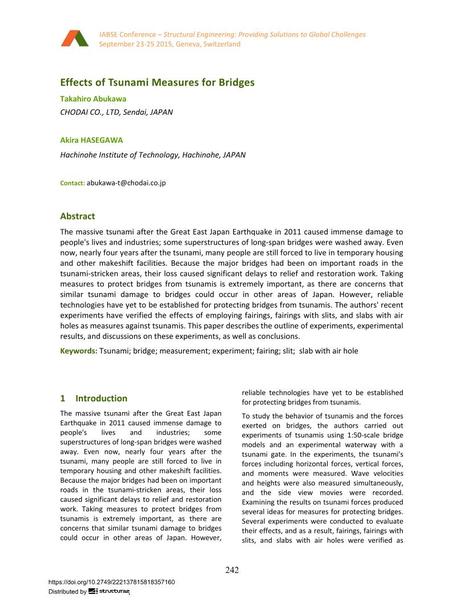Effects of Tsunami Measures for Bridges

|
|
|||||||||||
Bibliografische Angaben
| Autor(en): |
Takahiro Abukawa
(CHODAI CO., LTD, Sendai, JAPAN)
Akira Hasegawa (Hachinohe Institute of Technology, Hachinohe, JAPAN) |
||||
|---|---|---|---|---|---|
| Medium: | Tagungsbeitrag | ||||
| Sprache(n): | Englisch | ||||
| Tagung: | IABSE Conference: Structural Engineering: Providing Solutions to Global Challenges, Geneva, Switzerland, September 2015 | ||||
| Veröffentlicht in: | IABSE Conference Geneva 2015 | ||||
|
|||||
| Seite(n): | 242-247 | ||||
| Anzahl der Seiten (im PDF): | 6 | ||||
| Jahr: | 2015 | ||||
| DOI: | 10.2749/222137815818357160 | ||||
| Abstrakt: |
The massive tsunami after the Great East Japan Earthquake in 2011 caused immense damage to people's lives and industries; some superstructures of long-span bridges were washed away. Even now, nearly four years after the tsunami, many people are still forced to live in temporary housing and other makeshift facilities. Because the major bridges had been on important roads in the tsunami-stricken areas, their loss caused significant delays to relief and restoration work. Taking measures to protect bridges from tsunamis is extremely important, as there are concerns that similar tsunami damage to bridges could occur in other areas of Japan. However, reliable technologies have yet to be established for protecting bridges from tsunamis. The authors' recent experiments have verified the effects of employing fairings, fairings with slits, and slabs with air holes as measures against tsunamis. This paper describes the outline of experiments, experimental results, and discussions on these experiments, as well as conclusions. |
||||
| Stichwörter: |
Brücke Messungen
|
||||

